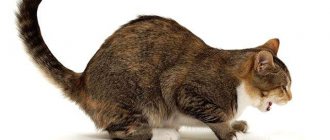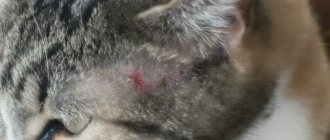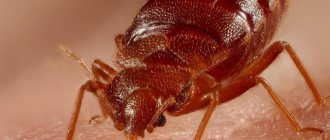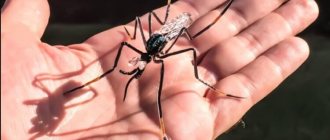A cat is one of the cleanest animals; it can lick its fur for hours, putting it in order. She does not change her habit either after eating and sleeping, or after visiting the toilet and petting her owners. But sometimes pet owners begin to notice that the cat is more habitually engaged in grooming than usual, and the habit of licking turns into manic obsession. Now all the time, outside of sleeping and eating, the cat constantly licks its fur. This behavior of the animal not only can, but should alert the owner.
Why does a cat constantly lick its tail?
The owners of tailed purrs notice this pathological habit immediately, because it can be terribly annoying, especially if the pet does it near people and even on their bed. You shouldn’t just drive the animal away, as there are many reasons for this behavior. Moreover, they all require contacting a veterinarian. A cat can lick its tail for hours due to:
- allergic reaction to certain foods;
- the presence of parasites in the body (with this disease, the cat will not lick the fur, but directly the anal entrance);
- skin damage on the tail.
A symptom such as licking under the tail often indicates that the pet is under stress. Stress can be caused by the fact that the house has another pet or is undergoing renovations. Constant licking has a calming effect on your furry pet.
Possible options
Every cat licks under its tail at least several times a week. This process should not be considered pathological, provided that the animal is regularly treated against fleas and ticks (at least once a month) and undergoes quarterly deworming. If you add accompanying symptoms such as redness in the anus, discharge or the appearance of growths, it is recommended to exclude the following diseases:
- Inflammation of the paraanal glands. It can form after eating bones, due to excess weight, soft food. Prolonged diarrhea can also be a cause. The first signs of inflammation may include fidgeting on the butt, constant licking under the tail, and redness in the anus. The problem can be solved by cleaning (at least once every three months, if there is a predisposition to inflammation). It is performed by a veterinarian in a hospital setting. After cleaning, ointments (proctosedyl) and suppositories (ichthyol or sea buckthorn) are prescribed. A change of food and increased hygiene are also indicated.
- Fleas. They can cause itching in different parts of the body. But most often bites occur on the base of the tail and stomach. Therefore, if a cat licks under its tail, behaves restlessly, tries to chew out fur, or tears itself with its paw until it bleeds, then flea treatment should be carried out. The fact that your pet does not leave the house is not 100% protection against parasites. The owner himself can bring them on clothes or the soles of shoes. Fleas are not dangerous to humans (they do not parasitize the skin), but in some cases they can bite. All animals are treated, regardless of the presence of symptoms. The most effective drugs are Stronghold and Frontline. They are produced in the form of drops, which are evenly applied to the withers so that the animal cannot lick the drug. It is recommended to perform this procedure at least once a month.
- Worms. The most common reason why a cat may lick under its tail frequently. Just like with fleas, an animal does not have to go outside to pick up parasites. He may develop them after being bitten by mosquitoes, mosquitoes, or fleas. Also at risk are pets whose diet contains raw meat and fish. Well, we cannot exclude the possibility that parasite eggs may enter the apartment on the soles of the shoes of the owner or his guests. The first signs of worms are itching in the anus, due to which the cat can ride on its butt on the floor. Licking and gnawing of fur in this area also indicate discomfort caused by parasites. Diarrhea, vomiting and increased appetite (or, conversely, complete refusal to eat) can be considered concomitant symptoms of helminthic infestation. Veterinarians recommend starting to worm animals from 3-4 weeks of age. As preparations, you can use tablets, suspensions or drops on the withers. Of the tablets, Drontal and Milbemax are considered the most effective. They can even be given in crushed form, adding to food. Some manufacturers offer meat-flavored tablets, since many pets flatly refuse to undergo deworming.
- Injury. This option cannot be ruled out. A pet can injure the anal area while climbing trees or after playing or fighting with other animals. Even a small scratch can cause significant discomfort. Because of this, a cat can constantly lick under its tail until it becomes bald. In such cases, it is recommended to carry out antiseptic treatment of the affected area until complete healing. And limit the animal's access to the wound using a special medical cap.
- Neoplasm. Unfortunately, this option should also be considered, especially if the animal is over 10 years old, it has been treated for parasites and there are no visible injuries in the anal area. The tumor can irritate the intestines, which explains the pet's restless behavior. The cat constantly licks under its tail, refuses to eat, and suffers from constipation. If necessary, the doctor performs diagnostic laparoscopy, during which cells are taken from the formation for histological examination. Depending on the type (sarcoma, lymphoma) of the tumor, treatment is selected (chemotherapy, surgical excision). Unfortunately, with tumors in the intestine, the prognosis is always cautious, even if the operation is successful and there are no metastases.
Finally, I would like to remind you that if a cat licks under its tail after giving birth, this may be an alarming signal for the development of pyometra, which can “burn” the animal in a few days. Therefore, in the postoperative period this symptom should not be ignored under any circumstances.
Why does a cat lick its fur in different places, but the animal has no fleas?
The presence of fleas in a pet is the first thing a cat owner thinks about if he notices that he is constantly licking his fur. Even if a quick examination did not reveal parasites in the fur, this does not mean that they are not there. Nits are not so clearly visible; they look like black, very small dots on the skin between the hairs.
However, the cause of constant licking of fur can be not only fleas, but also other skin parasites - scabies mites. It is quite easy to identify them by such signs as the presence of lesions on the skin in the area of the ankles, ears and elbows.
If a cat licks its fur mainly in the summer, but does not have fleas or parasites, there is a possibility that the pet has increased sensitivity to insect bites, such as mosquitoes.
Constant licking of a cat's fur in the absence of parasites may be an initial sign of one of the pathological conditions:
- depriving;
- dermatitis;
- endocrine system disorders;
- otitis;
- skin diseases - demodicosis, pyodermatitis.
All these pathologies, in addition to constant licking, are accompanied by other symptoms - the presence of wounds and erosions on the surface of the skin, areas of severe peeling.
Signs of lichen and fungal infections
Infection of the skin with lichen forces cats to clean their toilets more carefully than usual. If the owner notices that his pet has begun to lick its fur most of the time, you need to carefully examine its skin. If there is lichen on the skin, pockets of erosion or scabs will be visible between the hairs.
With fungus everything is much more complicated.
It is impossible to determine the presence of a fungal infection without examination by a veterinarian and instrumental examination using special equipment.
But there are a number of signs that an attentive owner will notice:
- excessive dry skin;
- the skin in certain areas changes its color, becomes paler or, conversely, stands out excessively, becoming darker or brighter by several tones;
- the appearance of gray scales that separate from the skin;
- the fur becomes thinner.
Similar signs may be present in other skin diseases, so it is not possible to make a diagnosis without a veterinarian.
Dermatitis
Identifying dermatitis in a cat is no less difficult a task than diagnosing a fungal infection. A cat will constantly lick its fur because it suffers from an incessant feeling of itching and burning. One of the most pronounced signs of dermatitis is the presence of inflammatory processes on the skin.
It is almost impossible to determine the presence of dermatitis at an early stage of its development, therefore, if the owner notices that his cat has clearly begun to lick itself longer and more often, it should be immediately shown to a veterinarian.
Otitis
An ear infection is always accompanied by severe itching. The cat will lick itself vigorously, damage its face and ears with its claws, and constantly shake its head. Other signs include redness of the inside of the ear, swelling and pus discharge.
Development of skin diseases
Demodecosis and pyodermitis are pathologies of the skin that are accompanied by severe and constant itching, while the cat experiences severe, ongoing discomfort. Due to the incessant “mange”, the cat begins to lick its fur and sometimes does it so intensely that bald patches appear on the fur.
Dermatitis in cats
Itching and pain of the skin can be caused by dermatitis.
This disease is caused by an immune disorder and the activation of opportunistic microorganisms on the animal's skin. Dermatitis is always accompanied by inflammation of the epidermis. With moderate inflammation, the animal becomes restless, itching, and the cat constantly licks its fur. Suspecting the disease at this stage is quite problematic.
We recommend the article: Should I worry if my cat's whiskers fall out?
In most cases, dermatitis is accompanied by visible symptoms - severe peeling of the skin, the formation of rashes, wounds and erosions. The rashes are most often localized on the pet's face, near the ears and on the neck.
Treatment is carried out using external agents, but only after identifying the pathogen.
Licking to the point of baldness
The owner of a purring dog may not even realize that constant, almost non-stop licking of fur is a symptom that the pet is in a state of psycho-emotional instability.
As a rule, all owners are accustomed to the fact that cats lick themselves because they have dermatitis or parasites, but it is also possible that the cat is experiencing real emotional torment. This picture can be observed when an animal needs to mate.
In order to normalize the pet’s condition, after which, accordingly, the bad habit of constantly licking the fur will go away, it is enough to give the cat to drink medications that have a sedative spectrum of action. But it should be borne in mind that they must be taken carefully so that they do not cause side symptoms or addiction in the pet.
If an unpleasant habit appeared after the castration procedure
The fact that an animal licks itself non-stop after sterilization is a normal, understandable phenomenon. After surgery, when the incision scar begins to heal, this process is accompanied by severe itching and burning. It is not surprising that the cat will try to relieve discomfort by constantly licking the skin.
But it is important for the owner to understand what this can lead to. If the suture is constantly wet after surgery, this will lead to poor and too slow healing and increase the risk of secondary infection.
To protect against negative consequences, the pet is recommended to wear a surgical collar for 10 days after castration, until the suture finally heals.
Diagnostic measures
Constant licking of fur is an alarming symptom, indicating that pathological processes are occurring in the animal’s body, often associated with mental instability and severe stress. Therefore, it is recommended to immediately take the cat to the veterinarian to identify the causes of this phenomenon and make an accurate diagnosis.
The veterinarian will conduct a visual examination of the animal and prescribe a number of laboratory tests. If dermatitis, fungal infection or infectious skin diseases are suspected, a bacteriological culture from the affected area is taken. If the doctor suspects that the cat has problems with the functioning of the endocrine system, it will be necessary to take a blood test for hormones.
Therapeutic measures
Constant licking of fur is not a separate disease, but a symptom of a certain pathology, so treatment is selected individually, depending on the diagnosis:
- If the cause of the symptom is diseases such as allergic reactions to food or hygiene products, local spectrum drugs are prescribed - ointments and creams that eliminate unpleasant symptoms, itching and burning. To prevent allergies from occurring again, you need to determine what exactly was the allergen, otherwise the discomfort will return again. In case of a severe allergic reaction, antihistamines are prescribed for internal use.
- Infections and inflammations on the skin of infectious origin require a course of antibiotics.
- If a fungus has been identified, antifungal medications are prescribed.
Also watch the video why cats lick themselves so often:
Passion for licking yourself
This is not your pet's love for cleanliness and order! You should sound the alarm, because you are dealing with a form of mental disorder in an animal. In science it is called “psychogenic alopecia.” Cats are more susceptible to this disorder, most often purebred cats, representatives of the so-called “eastern breeds”. They are much more excitable and have a delicate and sensitive nervous system. Through obsessive constant self-care, animals try to cope with internal experiences, stress, and try to put their thoughts and feelings in order. The reasons can be very different - moving to a new apartment, late guests, new family members or pets, even a change in the location of the tray. Try to find out what exactly makes your cat unbalanced, try to help her.











